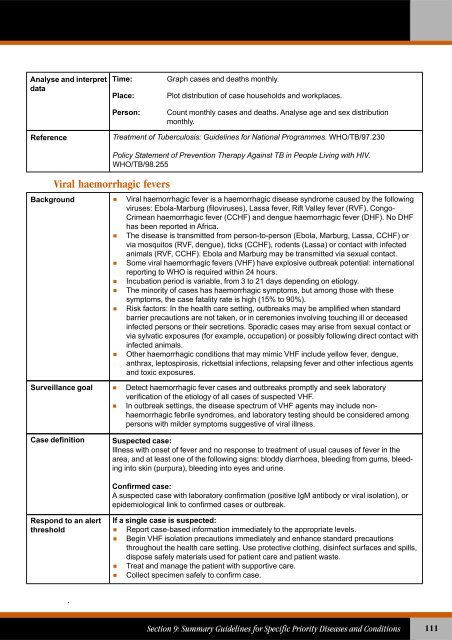Technical Guidelines for Integrated Disease Surveillance ... - PHRplus
Technical Guidelines for Integrated Disease Surveillance ... - PHRplus
Technical Guidelines for Integrated Disease Surveillance ... - PHRplus
Create successful ePaper yourself
Turn your PDF publications into a flip-book with our unique Google optimized e-Paper software.
Analyse and interpretdataTime:Place:Person:Graph cases and deaths monthly.Plot distribution of case households and workplaces.Count monthly cases and deaths. Analyse age and sex distributionmonthly.ReferenceTreatment of Tuberculosis: <strong>Guidelines</strong> <strong>for</strong> National Programmes. WHO/TB/97.230Policy Statement of Prevention Therapy Against TB in People Living with HIV.WHO/TB/98.255Viral haemorrhagic feversBackground Viral haemorrhagic fever is a haemorrhagic disease syndrome caused by the followingviruses: Ebola-Marburg (filoviruses), Lassa fever, Rift Valley fever (RVF), Congo-Crimean haemorrhagic fever (CCHF) and dengue haemorrhagic fever (DHF). No DHFhas been reported in Africa. The disease is transmitted from person-to-person (Ebola, Marburg, Lassa, CCHF) orvia mosquitos (RVF, dengue), ticks (CCHF), rodents (Lassa) or contact with infectedanimals (RVF, CCHF). Ebola and Marburg may be transmitted via sexual contact. Some viral haemorrhagic fevers (VHF) have explosive outbreak potential: internationalreporting to WHO is required within 24 hours. Incubation period is variable, from 3 to 21 days depending on etiology. The minority of cases has haemorrhagic symptoms, but among those with thesesymptoms, the case fatality rate is high (15% to 90%). Risk factors: In the health care setting, outbreaks may be amplified when standardbarrier precautions are not taken, or in ceremonies involving touching ill or deceasedinfected persons or their secretions. Sporadic cases may arise from sexual contact orvia sylvatic exposures (<strong>for</strong> example, occupation) or possibly following direct contact withinfected animals. Other haemorrhagic conditions that may mimic VHF include yellow fever, dengue,anthrax, leptospirosis, rickettsial infections, relapsing fever and other infectious agentsand toxic exposures.<strong>Surveillance</strong> goal Detect haemorrhagic fever cases and outbreaks promptly and seek laboratoryverification of the etiology of all cases of suspected VHF. In outbreak settings, the disease spectrum of VHF agents may include nonhaemorrhagicfebrile syndromes, and laboratory testing should be considered amongpersons with milder symptoms suggestive of viral illness.Case definitionSuspected case:Illness with onset of fever and no response to treatment of usual causes of fever in thearea, and at least one of the following signs: bloddy diarrhoea, bleeding from gums, bleedinginto skin (purpura), bleeding into eyes and urine.Confirmed case:A suspected case with laboratory confirmation (positive IgM antibody or viral isolation), orepidemiological link to confirmed cases or outbreak.Respond to an alertthresholdIf a single case is suspected: Report case-based in<strong>for</strong>mation immediately to the appropriate levels. Begin VHF isolation precautions immediately and enhance standard precautionsthroughout the health care setting. Use protective clothing, disinfect surfaces and spills,dispose safely materials used <strong>for</strong> patient care and patient waste. Treat and manage the patient with supportive care.Collect specimen safely to confirm case.Section 9: Summary <strong>Guidelines</strong> <strong>for</strong> Specific Priority <strong>Disease</strong>s and Conditions111















